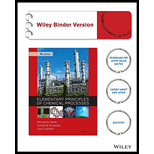
The hormone estrogen is produced in the ovaries of females and elsewhere in the body in men and postmenopausal women, and it is also administered in estrogen replacement therapy, a common treatment for w omen who have undergone a hysterectomy. Unfortunately, it also binds to estrogen receptors in breast tissue and can activate cells to become cancerous. Tamoxifen is a drug that also binds to estrogen receptors but does not activate cells, in effect blocking the receptors from access to estrogen and inhibiting the growth of breast-cancer cells.
Tamoxifen is administered in tablet form. In the manufacturing process, a finely ground powder contains tamoxifen (tam) and two inactive fillers—lactose monohydrate (lac) and com starch (cs). The powder is mixed w ith a second stream containing w ater and suspended solid particles of polyvinylpyrrolidone (pvp) binder, w hich keeps the tablets from easily crumbling. The slurry leaving the mixer goes to a dryer, in w hich 94.2% of the water fed to the process is vaporized. The w et pow der leasing the dryer contains 8.80 wt% tam. 66.8% lac. 21.4% cs, 2.00% pvp. and 1.00% water. After some additional processing, the pow der is molded into tablets. To produce a hundred thousand tablets, 17.13 kg of w et pow der is required.
- Taking a basis of 100,000 tablets produced, draw and label a process flowchart, labeling masses of individual components rather than total masses and component mass fractions. It is unnecessary to label the stream between the mixer and the dryer. Cany out a degree-of-freedom analysis of the overall two-unit process.
- Calculate the masses and compositions of the streams that must enter the mixer to make 100,(MX) tablets.
the balance equations are satisfied. There must have been a mistake in the degree-of-freedom calculation. What was it?
Trending nowThis is a popular solution!

Chapter 4 Solutions
Elementary Principles of Chemical Processes 4e Binder Ready Version + WileyPLUS Registration Card (Wiley Plus Products)
Additional Engineering Textbook Solutions
Starting Out With Visual Basic (8th Edition)
Mechanics of Materials (10th Edition)
Starting Out with C++: Early Objects (9th Edition)
Web Development and Design Foundations with HTML5 (8th Edition)
Starting Out with Java: From Control Structures through Objects (7th Edition) (What's New in Computer Science)
Introduction To Programming Using Visual Basic (11th Edition)
- =Naming benzene derivatives Name these organic compounds: structure C1 CH3 name ☐ CH3 ப C1 × ☐arrow_forwardBlocking Group are use to put 2 large sterically repulsive group ortho. Show the correct sequence toconnect the reagent to product with the highest yield possible. * see image **NOTE: The compound on the left is the starting point, and the compound on the right is the final product. Please show the steps in between to get from start to final, please. These are not two different compounds that need to be worked.arrow_forwardI dont understand this.arrow_forward
- Can you please explain this prooblem to me, show me how the conjugation is added, did I add them in the correct places and if so please show me. Thanks!arrow_forwardBasic strength of organic bases.arrow_forwardNucleophilic Aromatic Substitution: What is the product of the reaction? What is the name of the intermediate complex? *See imagearrow_forward
 Chemistry: The Molecular ScienceChemistryISBN:9781285199047Author:John W. Moore, Conrad L. StanitskiPublisher:Cengage Learning
Chemistry: The Molecular ScienceChemistryISBN:9781285199047Author:John W. Moore, Conrad L. StanitskiPublisher:Cengage Learning Chemistry for Today: General, Organic, and Bioche...ChemistryISBN:9781305960060Author:Spencer L. Seager, Michael R. Slabaugh, Maren S. HansenPublisher:Cengage Learning
Chemistry for Today: General, Organic, and Bioche...ChemistryISBN:9781305960060Author:Spencer L. Seager, Michael R. Slabaugh, Maren S. HansenPublisher:Cengage Learning Chemistry: Principles and ReactionsChemistryISBN:9781305079373Author:William L. Masterton, Cecile N. HurleyPublisher:Cengage Learning
Chemistry: Principles and ReactionsChemistryISBN:9781305079373Author:William L. Masterton, Cecile N. HurleyPublisher:Cengage Learning- Chemistry: Matter and ChangeChemistryISBN:9780078746376Author:Dinah Zike, Laurel Dingrando, Nicholas Hainen, Cheryl WistromPublisher:Glencoe/McGraw-Hill School Pub Co



